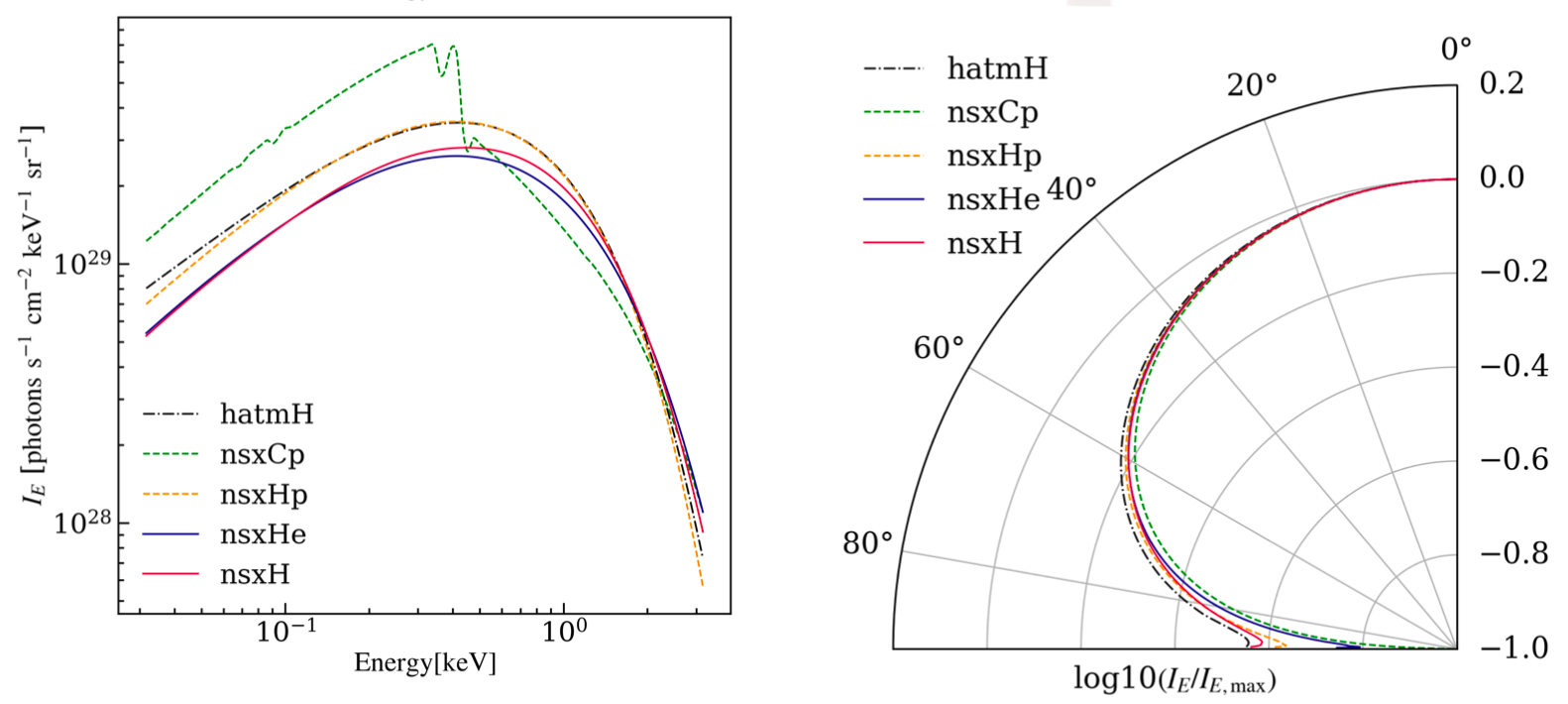NICER / ISS Science Nugget
for July 20, 2023
Exploring Neutron Star Atmospheres
In pursuit of its key science objectives, NICER has so far enabled mass and radius measurements, with unprecedented precision, of two neutron stars; several more such measurements are in work. These results are derived by modeling the physical processes on and near the surfaces of the stars, confronting the model with real-world data, and adjusting the model's parameters until a good match to the data is achieved. The specific neutron stars observed for this effort are a handful of "millisecond pulsars," which spin at hundreds of revolutions each second and sweep beams of X-rays across our telescopes that we perceive as pulses. The shapes of the received pulses depend on -- and thus encode -- details of the star's properties and the origin of the X-ray emission. For example, our models include the sizes, temperatures, and geometries of "hot spots" on the cold stellar surface that are responsible for the X-rays NICER detects. (The hot spots are thought to occur at the star's magnetic poles and are produced by radiation raining down from the powerful magnetosphere.) But before X-rays emitted at the surface can escape to space and reach us, they must pass through whatever atmosphere surrounds the neutron star.
Theory suggests that atmospheres must be dominated by light elements (because heavy elements settle rapidly to the surface in the star's extremely strong gravity), and should be approximately 1 centimeter thick. But the details are uncertain. The dominant element may be hydrogen, helium, or a mixture of both. Even carbon is a possibility, though considered unlikely. Because of the radiation environment and high temperatures, it's expected that the atmosphere's atoms are generally ionized, but some fraction of them may continue to hold on to their electrons. These details matter because they alter how X-rays generated at the surface propagate through the atmosphere. This week, a manuscript exploring the implications of different types of atmospheres, by T. Salmi (Univ. of Amsterdam) and collaborators, was accepted for publication in the peer-reviewed The Astrophysical Journal.
Past NICER studies assumed a fully-ionized hydrogen atmosphere above a hot surface, but also briefly considered the effects of partial ionization and helium composition in specific cases. The new paper includes additional models: partially ionized carbon composition, hydrogen heated from above, and others. None of the atmosphere variations studied were found to have a significant effect on the inferred radius of one of the neutron stars, PSR J0740+6620. In the case of the other, PSR J0030+0451, both the composition and ionization state can in principal alter the inferred radius, but the statistical evidence disfavors partially ionized hydrogen and carbon atmospheres. External heating had no significant effect on the inferred radius. The evidence for fully ionized hydrogen and helium atmospheres is inconclusive; if future data lend support to the helium atmosphere option, the inferred radius of the star would be higher than is currently believed. NICER continues to collect data on these key-science pulsar targets, to enable further fine-grained discrimination between physically viable models.

The effects of different assumptions about a neutron star's atmosphere on the spectrum (left) and angular distribution (right) of thermally emitted X-rays emerging from the surface below, for a given hot-spot temperature and stellar mass and radius. The model atmospheres shown are: externally heated, fully ionized hydrogen ("hatmH"), partially ionized carbon ("nsxCp"), partially ionized hydrogen ("nsxHp"), fully ionized helium ("nsxHe"), and fully ionized hydrogen ("nsxH"). In the right-hand panel, energy-dependent intensity I_E (as a ratio of its maximum value) is on the radial axis, while emission angle is shown relative to the surface perpendicular (0degree, vertical). (Credit: T. Salmi et al. 2023)
<< Previous
Main Index
Next >>